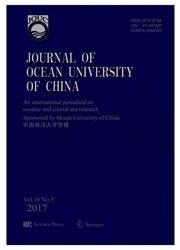

 中文摘要:
中文摘要:
Inter-annual variability of the Kuroshio water intrusion on the shelf of East China Sea (ECS) was simulated with a nested global and Northwest Pacific ocean circulation model.The model analysis reveals the influence of the variability of Kuroshio transport east of Taiwan on the intrusion to the northeast of Taiwan:high correlation (r=0.92) with the on-shore volume flux in the lower layer (50 200 m) ;low correlation (r=0.50) with the on-shore flux in the upper layer (0 50 m) .Spatial distribution of correlations between volume fluxes and sea surface height suggests that inter-annual variability of the Kuroshio flux east of Taiwan and its subsurface water intruding to the shelf lag behind the sea surface height anomalies in the central Pacific at 162 E by about 14 months,and could be related to wind-forced variation in the interior North Pacific that propagates westward as Rossby waves.The intrusion of Kuroshio surface water is also influenced by local winds.The intruding Kuroshio subsurface water causes variations of temperature and salinity of bottom waters on the southern ECS shelf.The influence of the intruding Kuroshio subsurface water extends widely from the shelf slope northeast of Taiwan northward to the central ECS near the 60 m isobath,and northeastward to the region near the 90 m isobath.
 英文摘要:
英文摘要:
Inter-annual variability of the Kuroshio water intrusion on the shelf of East China Sea (ECS) was simulated with a nested global and Northwest Pacific ocean circulation model. The model analysis reveals the influence of the variability of Kuroshio transport east of Taiwan on the intrusion to the northeast of Taiwan: high correlation (r = 0.92) with the on-shore volume flux in the lower layer (50-200 m); low correlation (r = 0.50) with the on-shore flux in the upper layer (0-50m). Spatial distribution of correlations between volume fluxes and sea surface height suggests that inter-annual variability of the Kuroshio flux east of Taiwan and its subsurface water intruding to the shelf lag behind the sea surface height anomalies in the central Pacific at 162~E by about 14 months, and could be related to wind-forced variation in the interior North Pacific that propagates westward as Rossby waves. The intrusion of Kuroshio surface water is also influenced by local winds. The intruding Kuroshio subsurface water causes variations of temperature and salinity of bottom waters on the southern ECS shelf. The influence of the intruding Kuroshio subsurface water extends widely from the shelf slope northeast of Taiwan northward to the central ECS near the 60 m isobath, and northeastward to the region near the 90 m isobath.
 同期刊论文项目
同期刊论文项目
 同项目期刊论文
同项目期刊论文
 期刊信息
期刊信息
